|
Palling Lifeboat Station
Palling Lifeboat Station was located at the town of Palling, on the north-east coast of Norfolk. A lifeboat was first stationed here by the Norfolk Association for Saving the Lives of Shipwrecked Mariners (NASLSM) in 1852. Management of the station was transferred to the Royal National Lifeboat Institution (RNLI) in 1858.[1] The station closed in 1930.[1] HistoryA lifeboat was sent to be stationed at Palling in 1852 by the Norfolk Association for Saving the Lives of Shipwrecked Mariners. She was a 32-foot Palmer type non-self-righting lifeboat, built by Branford, of Gt. Yarmouth, costing £75.[2] In 1857, the NASLSM made a request, that the RNLI take over responsibility for all their lifeboat stations, including Palling. This was formally agreed in 1858. A new lifeboat was ordered for Palling from Forrestt of Limehouse, London, a 30-foot 10-oared Peake-class self-righting lifeboat, and along with her specially constructed carriage, cost just over £250. Edward Amis was appointed Coxswain. She was housed in the boathouse built by the NASLSM, and would serve Palling for 6 years, being launched on service 6 times, and saving 20 lives.[2] The next lifeboat to be stationed at Palling was the Parsee. Originally a 30-foot lifeboat stationed at Hastings named Victoria, she was sent to Forrestt in London for conversion to be a 36-foot, 12-oared boat. She was transported to Gt. Yarmouth in February 1864 free of charge by the Great Eastern Railway Company, and then sailed up to Palling by the crew. In her 18 years on service at Palling, she rescued 103 lives in 23 launches.[2] On her first call on 23 December 1864, the Parsee went to the aid of the schooner Idas of Nantes, on passage from Danzig to Dunkirk, driven ashore at Palling. Six men were rescued.[3] Parsee was replaced by a new boat in 1882, the Heyland (ON 38), built by Woolfe of Shadwell. The boat was provided from funds raised in the memory of Lt. Heyland, RN, lost rescuing a seaman from H.M.S. Minotaur. But weighing 4 tons, she proved too heavy for the sandy conditions at Palling, and was soon replaced by Good Hope (ON 13) in 1884; again a 37-foot boat built by Woolfe, but weighing only 3 tons.[2] The No.2 station was closed in 1929. Motor-powered lifeboats had been placed on service at Cromer, 20 miles to the north, and Gorleston, 20 miles to the south, and it soon followed that the decision was made to close the No.1 station. This happened on 29 October 1930, with the removal of the lifeboat Jacob and Rachel Valentine (ON 580).[1] The parish of "Palling" was renamed "Sea Palling" on 2 October 1948.[4] Notable rescuesAt 4:30am on the 7 Mar 1907, Palling No.1 lifeboat 54th West Norfolk Regiment (ON 471) launched to the aid of the vessel Vixen. In pitch-black gale force conditions, the lifeboat managed to rescue 5 crew, but one man was left clinging to the rigging, cold, and unable to climb down by himself. The Master re-boarded the Vixen along with lifeboat crewman James Pestell. Pestell then climbed the rigging, and with the assistance of the Master, brought the man to the waiting lifeboat. With two of the party now on board, the lifeboat was hit by a large wave, and washed away from the wreck, leaving Pestell alone on the stricken vessel. Finally, the lifeboat returned, and Pestell was taken on board. For this service, James Pestell Jnr. was awarded the RNLI Silver Medal.[5] Station honoursThe following are awards made at Palling[5]
Palling lifeboatsAll-weather lifeboatsNo.1 Station
No.2 Station
See alsoNotes
References
External links |
||||||||||||||||||||||||||||||||||||||||||||||||||||||||||||||||||||||||||||||||||

